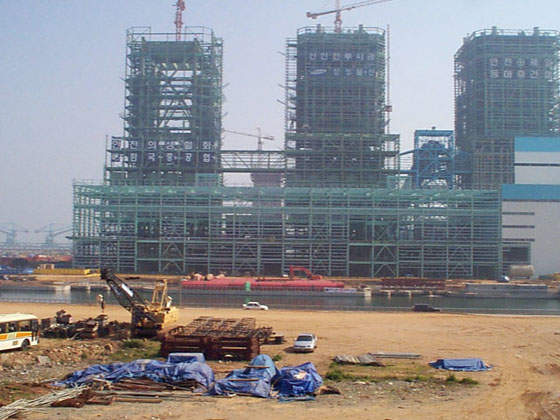The Dangjin power plant, consisting of four 600MW coal-fired units, is now operating in South Korea. The power station is fitted with low-NOx and coal-dust suppression equipment, and has desulphurisation and denitrification scrubbers.
Orders were placed in 1994 for the first pair of units, and in 1996 for the second pair. On-site construction of units one and two began in May 1995 and they were completed and commissioned in 1999. Operational service began in March 2000. Construction of units three and four was started in June 1995, and the main steel structure was erected in January 1997. These were completed more rapidly than the first two units and began operations in June 2001.
The operational mode of the plant is base load and middle load with fully automated operation. Total investment is around $2.7 billion.
PLANT MAKE-UP
Korea Electric Power Co (KEPCO) engineering subsidiary KOPEC was the prime architect-engineer and has been providing services ranging from preliminary plant design to start-up and tests, based on a standardised once-through supercritical boiler plant design with variable pressure operation capability.
Hanjung is the lead equipment supplier for Dangjin, building on its partnerships with GE and KEPCO in the design of the standard coal plant series. Hanjung manufactured boilers, turbines and generators. The turbines are tandem compound, reheat and condensing type. Dong Ah was the lead constructor.
ENVIRONMENTAL CONTROL
The Dangjin plant has been equipped with extensive environmental control facilities. A low NOx burner and two-stage burning will reduce nitrous oxide in the flue gas. Particulate air pollution will be controlled with coal dust suppression equipment, an electrostatic precipitator and high stacks. The flue gas will also pass through desulphurisation and denitrification scrubbers. Water pollution will be controlled with on-site plant wastewater treatment facilities. Silencers and soundproof walls will control noise pollution.
KOREAN POWER GENERATION
Electricity demand in Korea decreased in 1998 due to the economic difficulties, but throughout 2001 it increased to pre-recession rates and is expected to increase even further. Growth before the current recession had been at more than 10% per annum. The country’s long-term plan is to build 117 new power plants by 2015 to increase the country’s power generation capacity to 80,830MW.
Over 85% of electric power is currently generated by Korea Electric Power Co. (KEPCO). The remainder is generated by major conglomerates for their own use or by small Independent Power Projects (IPPs). Now however, as a result of the current economic problems and IMF imposed conditions, the Ministry of Trade, Industry and Energy (MOTIE) is revising the Business Act to bring about a competitive energy market.
The power generation division of KEPCO was spun off to six subsidiaries in November 1999. All the nuclear plants (12,000MW) will became one power company and five other companies share the 42 hydraulic and thermal power plants (including plants under construction) on an equal basis. The five thermal and hydraulic power companies have an average power generation capacity of 7,700MW.




